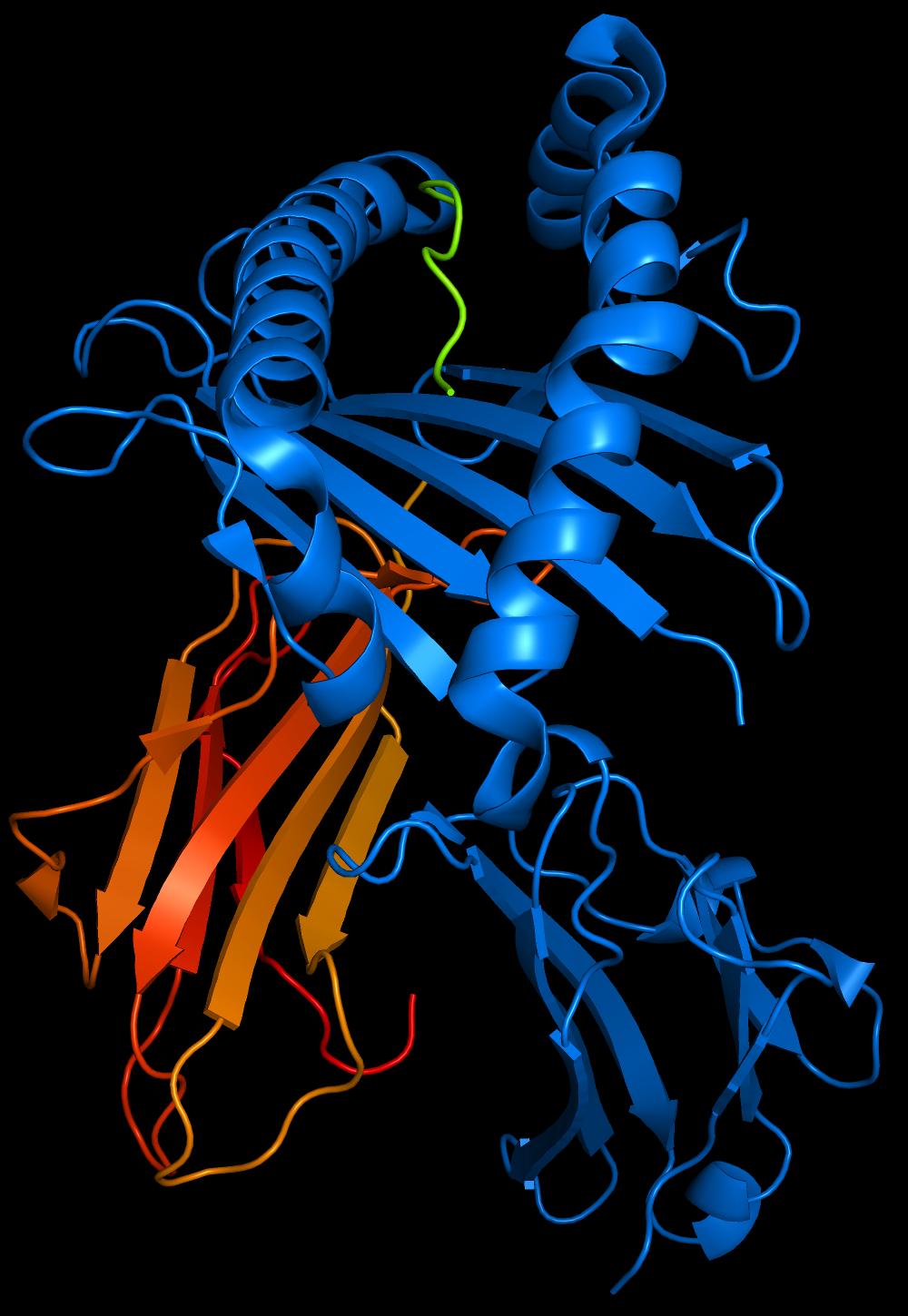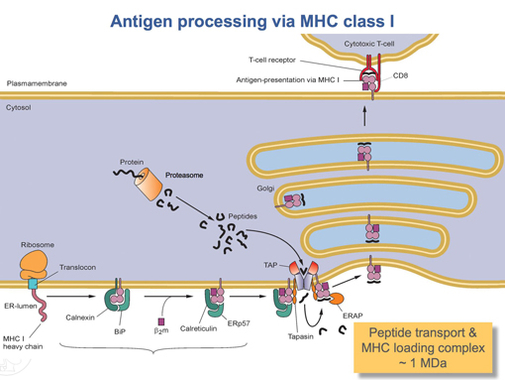|
HLA-B51
HLA-B51 (B51) is an HLA- B serotype. The serotype identifies the more common HLA-B*51 gene products. B51 is a split antigen of the broad antigen B5, and is a sister serotype of B52. There are many alleles within the B*51 allele group. B51 is associated with several diseases, including Behçet's disease. Serotype Alleles There are 71 alleles, 57 amino acid sequence variants in B51 of which 4 are nulls. Of these only 9 are frequent enough to have been reliably serotyped. B*5101 is the most common, but others have a large regional abundance. Disease associations By serotype Bw51 was associated with Behçet's disease, in endemic (versus epidemic) mucocutaneous lymph node syndrome, susceptibility to the virus that causes German measles infection. In Behçet's disease Behçet's disease is an inflammation of the wall of blood vessels that can involve the eyes, skin, and the rest of the body. Several alleles of B51 (B*5101, B*5108, B*5105, and B*5104) are found in disea ... [...More Info...] [...Related Items...] OR: [Wikipedia] [Google] [Baidu] |
Behçet's Disease
Behçet's disease (BD) is a type of inflammatory disorder which affects multiple parts of the body. The most common symptoms include painful sores on the mucous membranes of the mouth and other parts of the body, inflammation of parts of the eye, and arthritis. The sores can last from a few days, up to a week or more. Less commonly there may be inflammation of the brain or spinal cord, blood clots, aneurysms, or blindness. Often, the symptoms come and go. The cause is unknown. It is believed to be partly genetic. Behçet's is not contagious. Diagnosis is based on at least three episodes of mouth sores in a year together with at least two of the following: genital sores, eye inflammation, skin sores, a positive skin prick test. There is no cure. Treatments may include immunosuppressive medication such as corticosteroids and lifestyle changes. Lidocaine mouthwash may help with the pain. Colchicine may decrease the frequency of attacks. While rare in the United States an ... [...More Info...] [...Related Items...] OR: [Wikipedia] [Google] [Baidu] |
HLA-B
HLA-B (major histocompatibility complex, class I, B) is a human gene that provides instructions for making a protein that plays a critical role in the immune system. HLA-B is part of a family of genes called the human leukocyte antigen (HLA) complex. The HLA complex helps the immune system distinguish the body's own proteins from proteins made by foreign invaders such as viruses and bacteria. HLA is the human version of the major histocompatibility complex (MHC), a gene family that occurs in many species. Genes in this complex are separated into three basic groups: class I, class II, and class III. In humans, the HLA-B gene and two related genes, HLA-A and HLA-C, are the major genes in MHC class I. MHC class I genes provide instructions for making proteins that are present on the surface of almost all cells. On the cell surface, these proteins are bound to protein fragments (peptides) that have been exported from within the cell. MHC class I proteins display these peptides to t ... [...More Info...] [...Related Items...] OR: [Wikipedia] [Google] [Baidu] |
Sister Chromatid Exchange
Sister chromatid exchange (SCE) is the exchange of genetic material between two identical sister chromatids. It was first discovered by using the Giemsa staining method on one chromatid belonging to the sister chromatid complex before anaphase in mitosis. The staining revealed that few segments were passed to the sister chromatid which were not dyed. The Giemsa staining was able to stain due to the presence of bromodeoxyuridine analogous base which was introduced to the desired chromatid. The reason for the (SCE) is not known but it is required and used as a mutagenic testing of many products. Four to five sister chromatid exchanges per chromosome pair, per mitosis is in the normal distribution, while 14-100 exchanges is not normal and presents a danger to the organism. SCE is elevated in pathologies including Bloom syndrome, having recombination rates ~10-100 times above normal, depending on cell type. Frequent SCEs may also be related to formation of tumors. Sister chromatid ex ... [...More Info...] [...Related Items...] OR: [Wikipedia] [Google] [Baidu] |
HLA-B5
HLA-B5 (B5) is an HLA- B serotype. B5 is a broad antigen serotype that recognizes the B51 and B52 split antigen Split(s) or The Split may refer to: Places * Split, Croatia, the largest coastal city in Croatia * Split Island, Canada, an island in the Hudson Bay * Split Island, Falkland Islands * Split Island, Fiji, better known as Hạfliua Arts, entert ... serotypes. Serotype References {{HLA-B serotypes 0 ... [...More Info...] [...Related Items...] OR: [Wikipedia] [Google] [Baidu] |
HLA-B52
HLA-B52 (B52) is an HLA- B serotype. The serotype identifies the more common HLA-B*52 gene products. B52 is a split antigen of the broad antigen B5, and is a sister type of B51. B*5201 likely formed as a result of a gene conversion event between another HLA-B allele and HLA-B*5101. There are a number of alleles within the B*52 allele group. Serotype Alleles There are 18 alleles, with 14 amino acid sequence variants in B52. Of these only 9 are frequent enough to have been reliably serotyped. B*5201 is the most common, but others have a large regional abundance. Disease In ulcerative colitis HLA-B52 appears to have the strongest linkage to ulcerative colitis in Japan. This form of disease is frequently found with Takayasu's arteritis. In Takayasu's arteritis Takayasu's arteritis appears to have an independent link to B52 associated disease. The association with B*5201 increases risk of pulmonary infarction, ischemic heart disease, aortic regurgitation, systemic hyperten ... [...More Info...] [...Related Items...] OR: [Wikipedia] [Google] [Baidu] |
Human Leukocyte Antigen
The human leukocyte antigen (HLA) system or complex is a complex of genes on chromosome 6 in humans which encode cell-surface proteins responsible for the regulation of the immune system. The HLA system is also known as the human version of the major histocompatibility complex (MHC) found in many animals. Mutations in HLA genes may be linked to autoimmune disease such as type I diabetes, and celiac disease. The HLA gene complex resides on a 3 Mbp stretch within chromosome 6, p-arm at 21.3. HLA genes are highly polymorphic, which means that they have many different alleles, allowing them to fine-tune the adaptive immune system. The proteins encoded by certain genes are also known as ''antigens'', as a result of their historic discovery as factors in organ transplants. HLAs corresponding to MHC class I ( A, B, and C), all of which are the HLA Class1 group, present peptides from inside the cell. For example, if the cell is infected by a virus, the HLA system brings fragme ... [...More Info...] [...Related Items...] OR: [Wikipedia] [Google] [Baidu] |
Rubella Virus
Rubella virus (RuV) is the pathogenic agent of the disease rubella, transmitted only between humans via the respiratory route, and is the main cause of congenital rubella syndrome when infection occurs during the first weeks of pregnancy. Rubella virus, scientific name ''Rubivirus rubellae'', is a member of the genus '' Rubivirus'' and belongs to the family of ''Matonaviridae'', whose members commonly have a genome of single-stranded RNA of positive polarity which is enclosed by an icosahedral capsid. the molecular basis for the causation of congenital rubella syndrome was not yet completely clear, but ''in vitro'' studies with cell lines showed that rubella virus has an apoptotic effect on certain cell types. There is evidence for a p53-dependent mechanism. Taxonomy Rubella virus (''Rubivirus rubellae'') is assigned to the ''Rubivirus'' genus. ''Matonaviridae'' family Until 2018, Rubiviruses were classified as part of the family ''Togaviridae'', but have since been changed ... [...More Info...] [...Related Items...] OR: [Wikipedia] [Google] [Baidu] |
SUMO4
Small ubiquitin-related modifier 4 is a protein that in humans is encoded by the ''SUMO4'' gene. Function This gene is a member of the SUMO gene family. This family of genes encode small ubiquitin-related modifiers that are attached to proteins and control the target proteins' subcellular localization, stability, or activity. The protein described in this record is located in the cytoplasm and specifically modifies IKBA, leading to negative regulation of NF-kappa-B-dependent transcription of the IL12B gene. A specific polymorphism in this SUMO gene, which leads to the M55V substitution, has been associated with type I diabetes. The RefSeq contains this polymorphism. Interactions SUMO4 has been shown to interact with IκBα IκBα (nuclear factor of kappa light polypeptide gene enhancer in B-cells inhibitor, alpha) is one member of a family of cellular proteins that function to inhibit the NF-κB transcription factor. IκBα inhibits NF-κB by masking the nuclear lo .... ... [...More Info...] [...Related Items...] OR: [Wikipedia] [Google] [Baidu] |
MHC Class I Polypeptide-related Sequence A
MHC may refer to: Biology *Major histocompatibility complex, a highly polymorphic region on chromosome 6 with genes particularly involved in immune functions *Myosin heavy chain, part of the motor protein myosin's quaternary protein structure Colleges * Mars Hill College (now Mars Hill University), a college in Mars Hill, North Carolina, USA * Mount Holyoke College, a college in South Hadley, Massachusetts, USA * William E. Macaulay Honors College, an honors college within the City University of New York Health * Managed health care * Mental health counselor * Metropolitan Hospital Center, East Harlem, New York City Sports * Malaysian Hockey Confederation * Mediterranean Handball Confederation * Mid Hudson Conference * Milwaukee Hurling Club Other * Maimonides Heritage Center * Massachusetts Historical Commission * Mile high club * Mochoʼ language (ISO 639:mhc), a moribund Mayan language spoken in Chiapas, Mexico * Mocopulli Airport (IATA: MHC), Dalcahue, Los Lagos, Chile * Mo ... [...More Info...] [...Related Items...] OR: [Wikipedia] [Google] [Baidu] |
Vasculitis
Vasculitis is a group of disorders that destroy blood vessels by inflammation. Both arteries and veins are affected. Lymphangitis (inflammation of lymphatic vessels) is sometimes considered a type of vasculitis. Vasculitis is primarily caused by leukocyte migration and resultant damage. Although both occur in vasculitis, inflammation of veins (phlebitis) or arteries (arteritis) on their own are separate entities. Signs and symptoms Possible signs and symptoms include: * General symptoms: Fever, unintentional weight loss * Skin: Palpable purpura, livedo reticularis * Muscles and joints: Muscle pain or inflammation, joint pain or joint swelling * Nervous system: Mononeuritis multiplex, headache, stroke, tinnitus, reduced visual acuity, acute visual loss * Heart and arteries: Heart attack, high blood pressure, gangrene * Respiratory tract: Nosebleeds, bloody cough, lung infiltrates * GI tract: Abdominal pain, bloody stool, perforations (hole in the GI tract) * Kidneys: Inflamma ... [...More Info...] [...Related Items...] OR: [Wikipedia] [Google] [Baidu] |
German Measles
Rubella, also known as German measles or three-day measles, is an infection caused by the rubella virus. This disease is often mild, with half of people not realizing that they are infected. A rash may start around two weeks after exposure and last for three days. It usually starts on the face and spreads to the rest of the body. The rash is sometimes itchy and is not as bright as that of measles. Swollen lymph nodes are common and may last a few weeks. A fever, sore throat, and fatigue may also occur. Joint pain is common in adults. Complications may include bleeding problems, testicular swelling, encephalitis, and inflammation of nerves. Infection during early pregnancy may result in a miscarriage or a child born with congenital rubella syndrome (CRS). Symptoms of CRS manifest as problems with the eyes such as cataracts, deafness, as well as affecting the heart and brain. Problems are rare after the 20th week of pregnancy. Rubella is usually spread from one person to t ... [...More Info...] [...Related Items...] OR: [Wikipedia] [Google] [Baidu] |
HLA-A
HLA-A is a group of human leukocyte antigens (HLA) that are encoded by the HLA-A locus, which is located at human chromosome 6p21.3. HLA is a major histocompatibility complex (MHC) antigen specific to humans. HLA-A is one of three major types of human MHC class I transmembrane proteins. The others are HLA-B and HLA-C. The protein is a heterodimer, and is composed of a heavy α chain and smaller β chain. The α chain is encoded by a variant HLA-A gene, and the β chain (β2-microglobulin) is an invariant β2 microglobulin molecule. The β2 microglobulin protein is encoded by the B2M gene, which is located at chromosome 15q21.1 in humans. MHC Class I molecules such as HLA-A are part of a process that presents short polypeptides to the immune system. These polypeptides are typically 7-11 amino acids in length and originate from proteins being expressed by the cell. There are two classes of polypeptide that can be presented by an HLA protein: those that are supposed to be expressed ... [...More Info...] [...Related Items...] OR: [Wikipedia] [Google] [Baidu] |





